Flood Flow Frequency Analysis to Estimate Potential Floodplain Nitrogen Treatment during Overbank Flow Events in Urban Stream Restoration Projects
Abstract
1. Introduction
2. Materials and Methods
2.1. Site Selection
2.2. Bankfull and Top of Bank Discharge Determinations
2.3. Annual Flow Volume Interacting with the Floodplain
2.4. Nutrient Processing and Retention on the Floodplain
2.5. Treatment Depth and Treatment Sensitivity Analysis
3. Results and Discussion
3.1. Annual Flow Volume
3.2. N Retention on the Floodplain
3.3. Sensitivity Analysis
3.4. Comparison to CBP Protocol and Limitations
4. Conclusions
- On average, 11% of the total flow volume accessed the floodplain;
- A large majority of this volume occurred during only a few large events, which largely overwhelm the treatment potential of the floodplain. In total, 90% of the floodplain flow occurred during half of all overbank events, while 50% of overbank flow occurred in only two to three events each year;
- Using flow separation analysis, TN retention/removal ranged from 0.2% to 1.0% across these five sites;
- Sensitivity analysis showed that, even if treatment efficiency was high (90%) and treatment depth was doubled to 60 cm, TN retention/removal would still be less than 3% for all but one site.
Author Contributions
Funding
Acknowledgments
Conflicts of Interest
References
- Bernhardt, E.S.; Palmer, M.A.; Allan, J.D.; Alexander, G.; Barnas, K.; Brooks, S.; Carr, J.; Clayton, S.; Dahm, C.; Follstad-Shah, J.; et al. Synthesizing U.S. River Restoration Efforts. Science (80-) 2005, 308, 636–637. [Google Scholar] [CrossRef] [PubMed]
- Thompson, J.; Pelc, C.E.; Brogan, W.R.; Jordan, T.E. The multiscale effects of stream restoration on water quality. Ecol. Eng. 2018, 124, 7–18. [Google Scholar] [CrossRef]
- McMillan, S.K.; Noe, G.B. Increasing floodplain connectivity through urban stream restoration increases nutrient and sediment retention. Ecol. Eng. 2017, 108, 284–295. [Google Scholar] [CrossRef]
- Van Houtven, G.; Loomis, R.; Casey, S.; Beach, R.H.; Baker, J.S. Nutrient Credit Trading for the Chesapeake Bay: An Economic Study; Chesepeake Bay Commision, RTI International: Research Triange Park, NC, USA, 2012. [Google Scholar]
- NC DEQ NC DEQ: Tar-Pamlico Nutrient Strategy. North Carolina Department of Environmental Quality. Available online: https://deq.nc.gov/about/divisions/water-resources/planning/nonpoint-source-management/nutrient-strategies/tar-pamlico#stormwater-and-nutrient-offsets (accessed on 23 April 2020).
- Kaushal, S.S.; Groffman, P.M.; Mayer, P.M.; Striz, E.; Gold, A.J. Effects of stream restoration on denitrification in an urbanizing watershed. Ecol. Appl. 2008, 18, 789–804. [Google Scholar] [CrossRef] [PubMed]
- Lammers, R.W.; Bledsoe, B.P. What role does stream restoration play in nutrient management? Crit. Rev. Environ. Sci. Technol. 2017, 47, 335–371. [Google Scholar] [CrossRef]
- Reddy, K.R.; DeLaune, R.D. Biogeochemistry of Wetlands: Science and Applications; CRC Press: Boca Raton, FL, USA, 2008; ISBN 0203491459. [Google Scholar]
- Mitsch, W.J.; Gosselink, J.G. Wetlands, 5th ed.; John Wiley & Sons: Hoboken, NJ, USA, 2015; ISBN 1118676823. [Google Scholar]
- Verhoeven, J.T.A.; Arheimer, B.; Yin, C.; Hefting, M.M. Regional and global concerns over wetlands and water quality. Trends Ecol. Evol. 2006, 21, 96–103. [Google Scholar] [CrossRef] [PubMed]
- Jordan, T.E. Wetland Restoration and Creation Best Management Practice (Agricultural). In Definition of Nutrient and Sediment Reduction Efficiencies for Use in Calibration of the Phase 5.0 Chesapeake Bay Program Watershed Model; Smithsonian Environmental Research Center: Edgewater, MD, USA, 2007. [Google Scholar]
- Kadlec, R.H.; Wallace, S.D. Treatment Wetlands, 2nd ed.; CRC Press: Boca Raton, FL, USA, 2009; ISBN 9781566705264. [Google Scholar]
- Kovacic, D.A.; David, M.B.; Gentry, L.E.; Starks, K.M.; Cooke, R.A. Effectiveness of Constructed Wetlands in Reducing Nitrogen and Phosphorus Export from Agricultural Tile Drainage. J. Environ. Qual. 2000, 29, 1262–1274. [Google Scholar] [CrossRef]
- Stack, B. Email message to first author. 5 February 2020. [Google Scholar]
- Doll, B.A.; Wise-Frederick, D.E.; Buckner, C.M.; Wilkerson, S.D.; Harman, W.A.; Smith, R.E.; Spooner, J. Hydraulic geometry relationships for urban streams throughout the Piedmont of North Carolina. J. Am. Water Resour. Assoc. 2002, 38, 641–651. [Google Scholar] [CrossRef]
- NCFMP. North Carolina Flood Risk Information System. North Carolina Floodplain Mapping Program. Available online: https://fris.nc.gov/fris/Home.aspx?ST=NC (accessed on 1 July 2018).
- USACE. HEC-RAS 5.0; USACE Institute for Water Resources Hydrologic Engineering Center: Davis, CA, USA, 2016. [Google Scholar]
- Richardson, C.J.; Flanagan, N.E.; Ho, M.; Pahl, J.W. Integrated stream and wetland restoration: A watershed approach to improved water quality on the landscape. Ecol. Eng. 2011, 37, 25–39. [Google Scholar] [CrossRef]
- Belt, K.T.; Stack, B.; Pouyat, R.; Burgess, K.; Groffman, P.M.; Frost, W.; Kaushal, S.; Hager, G. Ultra-urban Baseflow and Stormflow Concentrations and Fluxes in a Watershed Undergoing Restoration. In Proceedings of the Water Environment Federation 2012 (WEFTEC), New Orleans, LA, USA, 29 September–3 October 2012. [Google Scholar]
- Janke, B.D.; Finlay, J.C.; Hobbie, S.E.; Baker, L.A.; Sterner, R.W.; Nidzgorski, D.; Wilson, B.N. Contrasting influences of stormflow and baseflow pathways on nitrogen and phosphorus export from an urban watershed. Biogeochemistry 2014, 121, 209–228. [Google Scholar] [CrossRef]
- Jordan, T.E.; Whigham, D.F.; Hofmockel, K.H.; Pittek, M.A. Nutrient and sediment removal by a restored wetland receiving agricultural runoff. J. Environ. Qual. 2003, 32, 1534–1547. [Google Scholar] [CrossRef] [PubMed]
- ArcGIS Desktop: Release 10; Environmental Systems Research Institute: Redlands, CA, USA, 2016.
- Schueler, T.; Stack, B. Recommendations of the Expert Panel to Define Removal Rates for Individual Stream Restoration Projects; Chesapeake Bay Program: Annapolis, MD, USA, 2013. [Google Scholar]
- Scott, D.T.; Gomez-Velez, J.D.; Jones, C.N.; Harvey, J.W. Floodplain inundation spectrum across the United States. Nat. Commun. 2019, 10, 5194. [Google Scholar] [CrossRef] [PubMed]
- Walsh, J.; Wuebbles, D.; Hayhoe, K.; Kossin, J.; Kunkel, K.; Stephens, G.; Thorne, P.; Vose, R.; Wehner, M.; Willis, J.; et al. Our Changing Climate. Climate Change Impacts in the United States: The Third National Climate Assessment; PDF Revised: Washington, DC, USA, 2014. [Google Scholar]
- US EPA. Stormwater Technology Fact Sheet: Stormwater Wetlands; EPA: Washington, DC, USA, 1999. [Google Scholar]
- Lee, C.G.; Fletcher, T.D.; Sun, G. Nitrogen removal in constructed wetland systems. Eng. Life Sci. 2009, 9, 11–22. [Google Scholar] [CrossRef]
- Van der Lee, G.E.M.; Olde Venterink, H.; Asselman, N.E.M. Nutrient retention in floodplains of the Rhine distributaries in The Netherlands. River Res. Appl. 2004, 20, 315–325. [Google Scholar] [CrossRef]
- Craig, L.S.; Palmer, M.A.; Richardson, D.C.; Filoso, S.; Bernhardt, E.S.; Bledsoe, B.P.; Doyle, M.W.; Groffman, P.M.; Hassett, B.A.; Kaushal, S.S.; et al. Stream restoration strategies for reducing river nitrogen loads. Front. Ecol. Environ. 2008, 6, 529–538. [Google Scholar] [CrossRef]
- Hammersmark, C.T.; Rains, M.C.; Mount, J.F. Quantifying the hydrological effects of stream restoration in a montane meadow, northern California, USA. River Res. Appl. 2008, 24, 735–753. [Google Scholar] [CrossRef]
- Filoso, S.; Palmer, M.A. Assessing stream restoration effectiveness at reducing nitrogen export to downstream waters. Ecol. Appl. 2011, 21, 1989–2006. [Google Scholar] [CrossRef] [PubMed]
- Doll, B.A.; Johnson, J.P.; Page, J.; Line, D.E. Evaluation of Nutrient Reduction Crediting Strategies for Stream Restoration; NC State University, Bio & Ag Engineering Dept.: Raleigh, NC, USA, 2018. [Google Scholar]
- Beisch, B.; Forasté, A. CBP Protocols to Define Removal Rates for Individual Stream Restoration Projects; Williamsburg Environmental Group: Richmond, VA, USA, 2013. [Google Scholar]
- USGS. The Quality of Our Nation’s Waters; Nutrients and Pesticides; U.S. Geological Survey: Reston, VA, USA, 1999.
- USGS. The Quality of Our Nation’s Waters—Nutrients in the Nation’s Streams and Groundwater; U.S. Geological Survey: Reston, VA, USA, 2010.
- Opperman, J.J.; Moyle, P.B.; Larsen, E.W.; Florsheim, J.L.; Manfree, A.D. Floodplains: Processes and Management for Ecosystem Services; University of California Press: Berkeley, CA, USA, 2017; ISBN 9780520294103. [Google Scholar]
- Ahilan, S.; Guan, M.; Sleigh, A.; Wright, N.; Chang, H. The influence of floodplain restoration on flow and sediment dynamics in an urban river. J. Flood Risk Manag. 2018, 11, S986–S1001. [Google Scholar] [CrossRef]
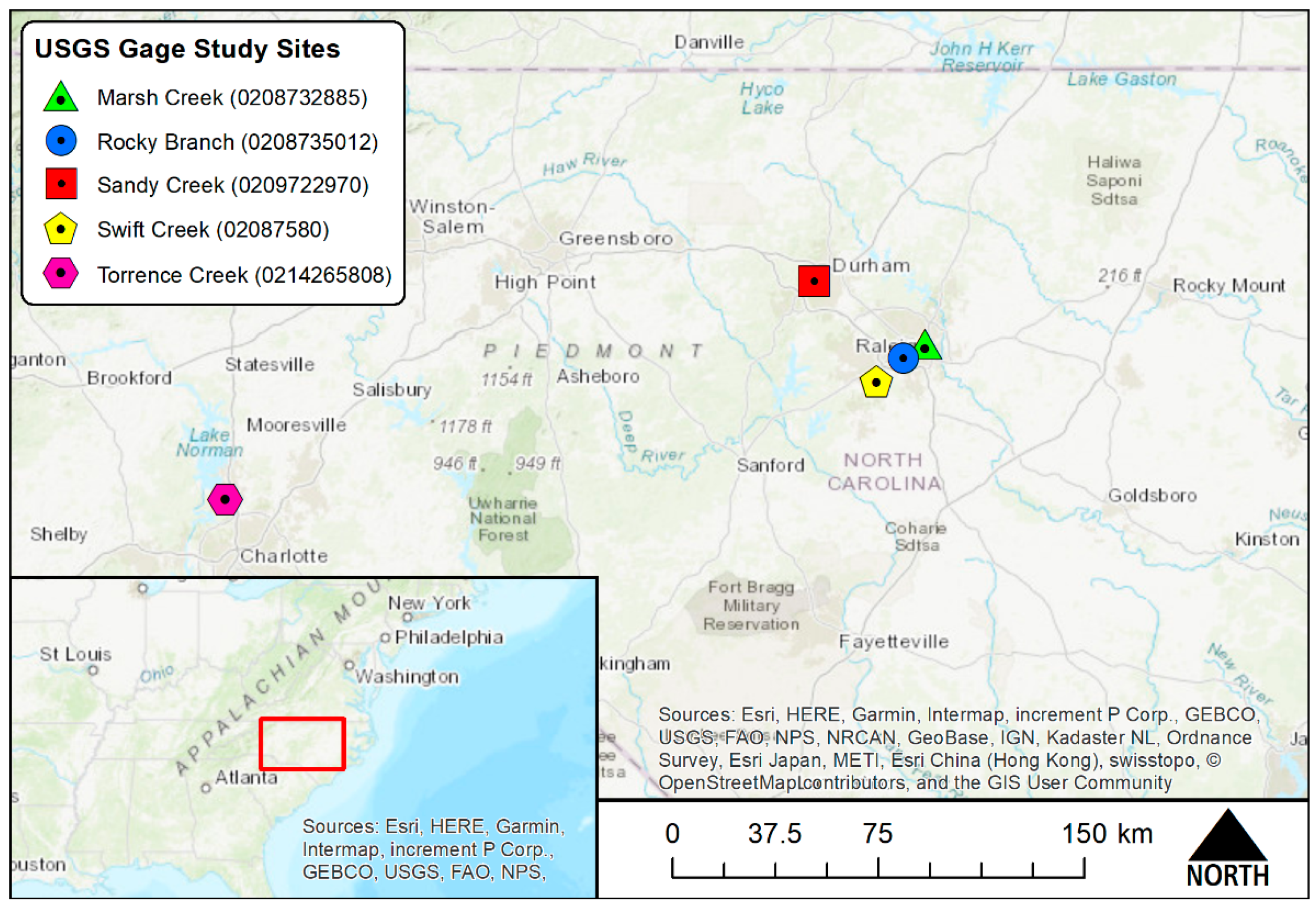
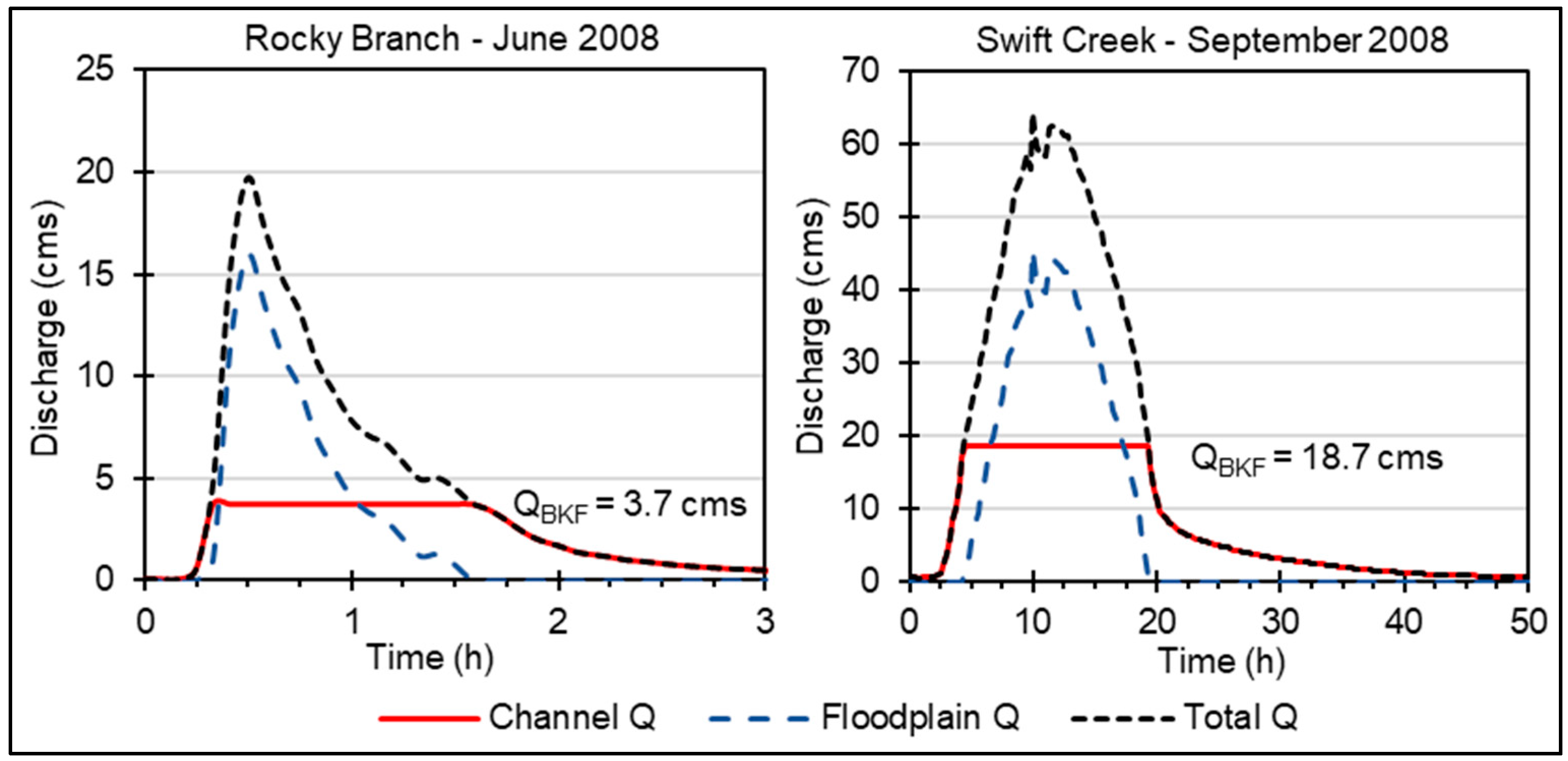
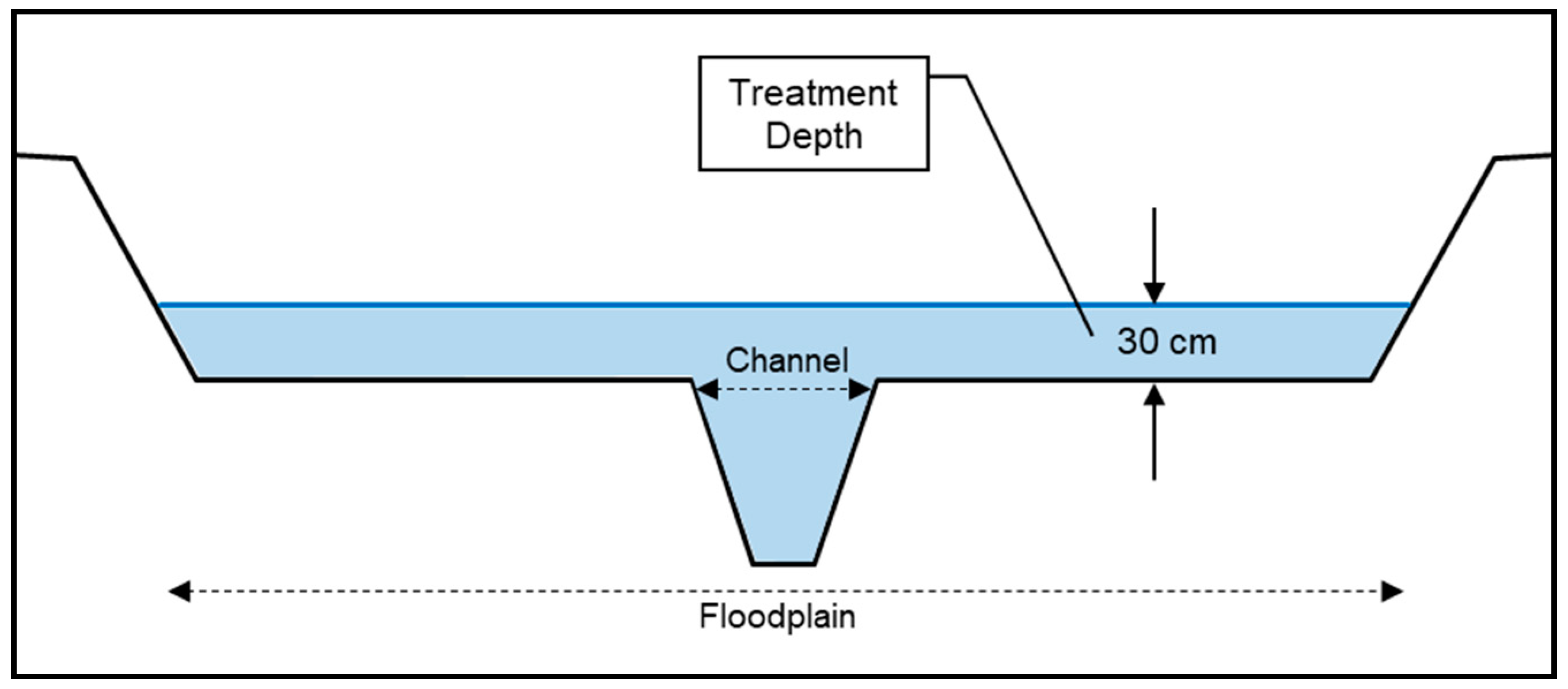
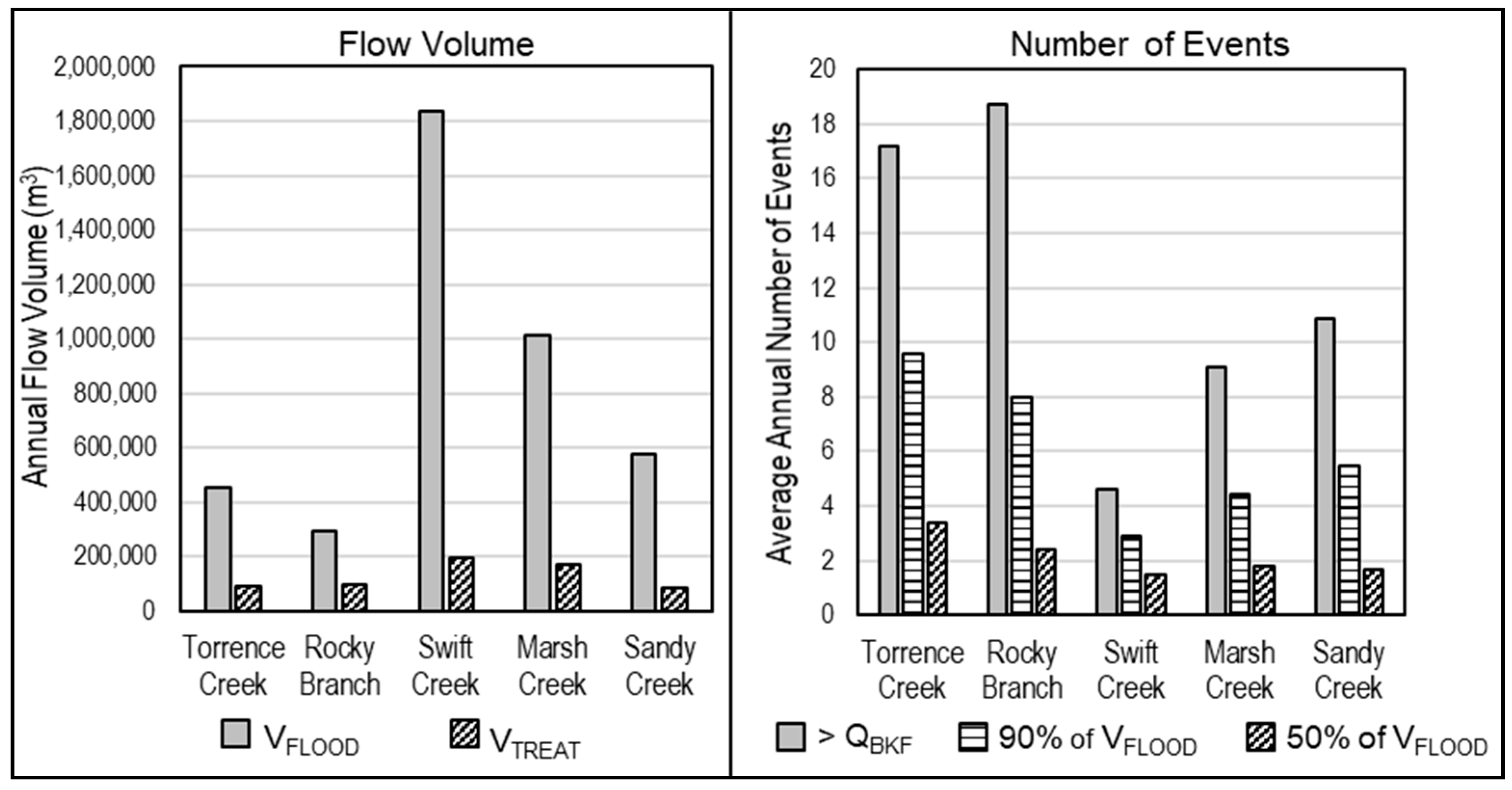
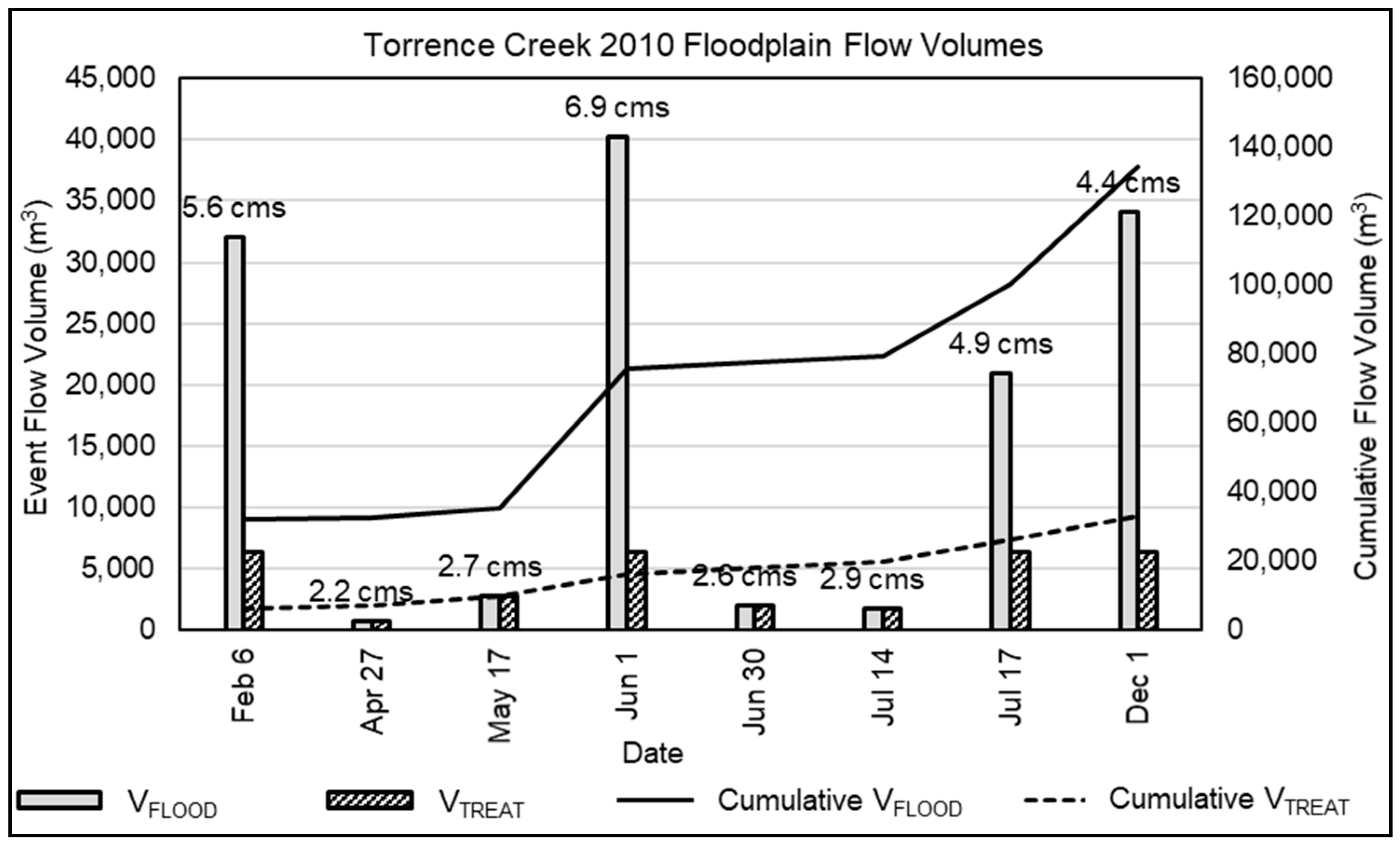
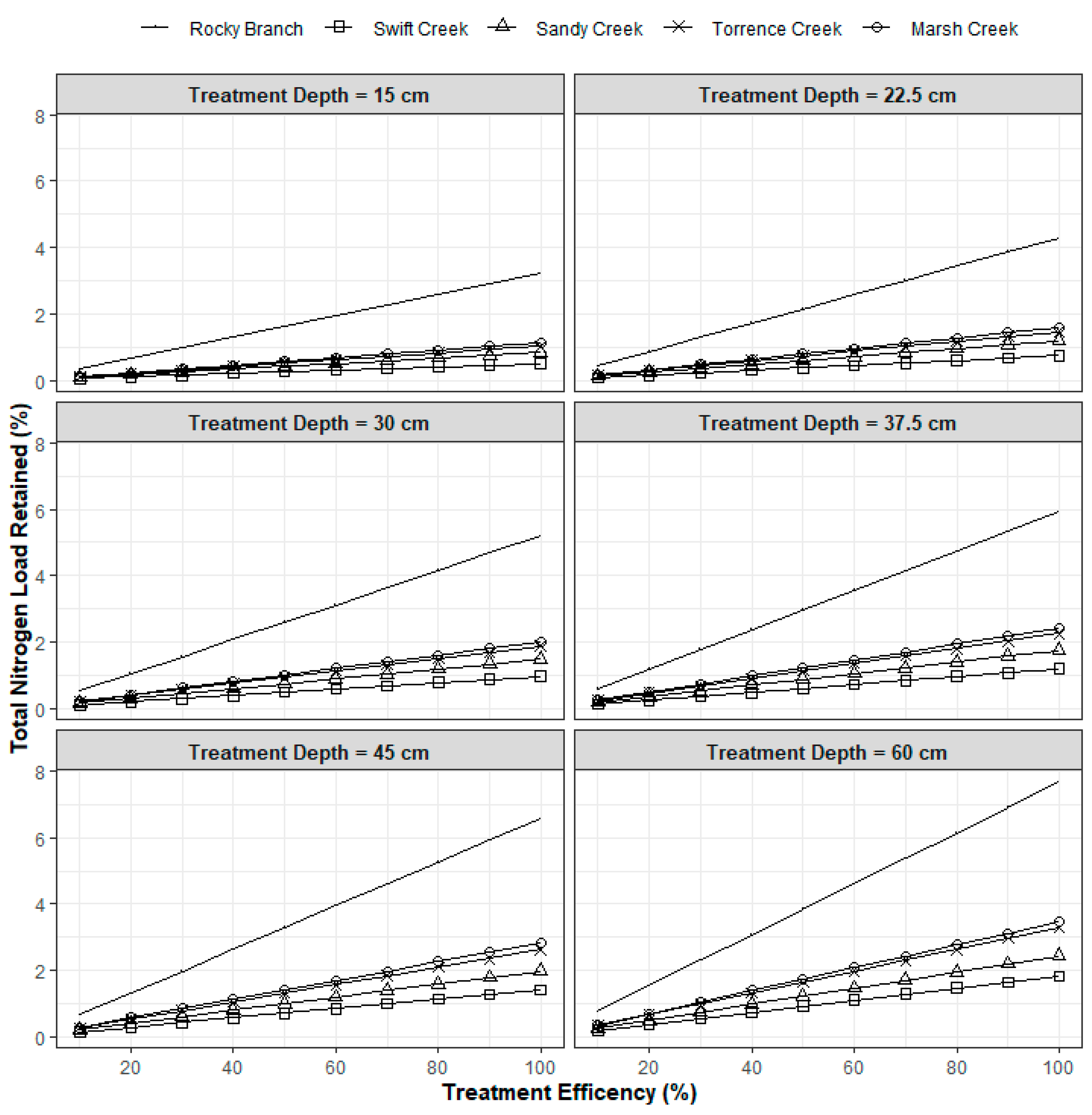
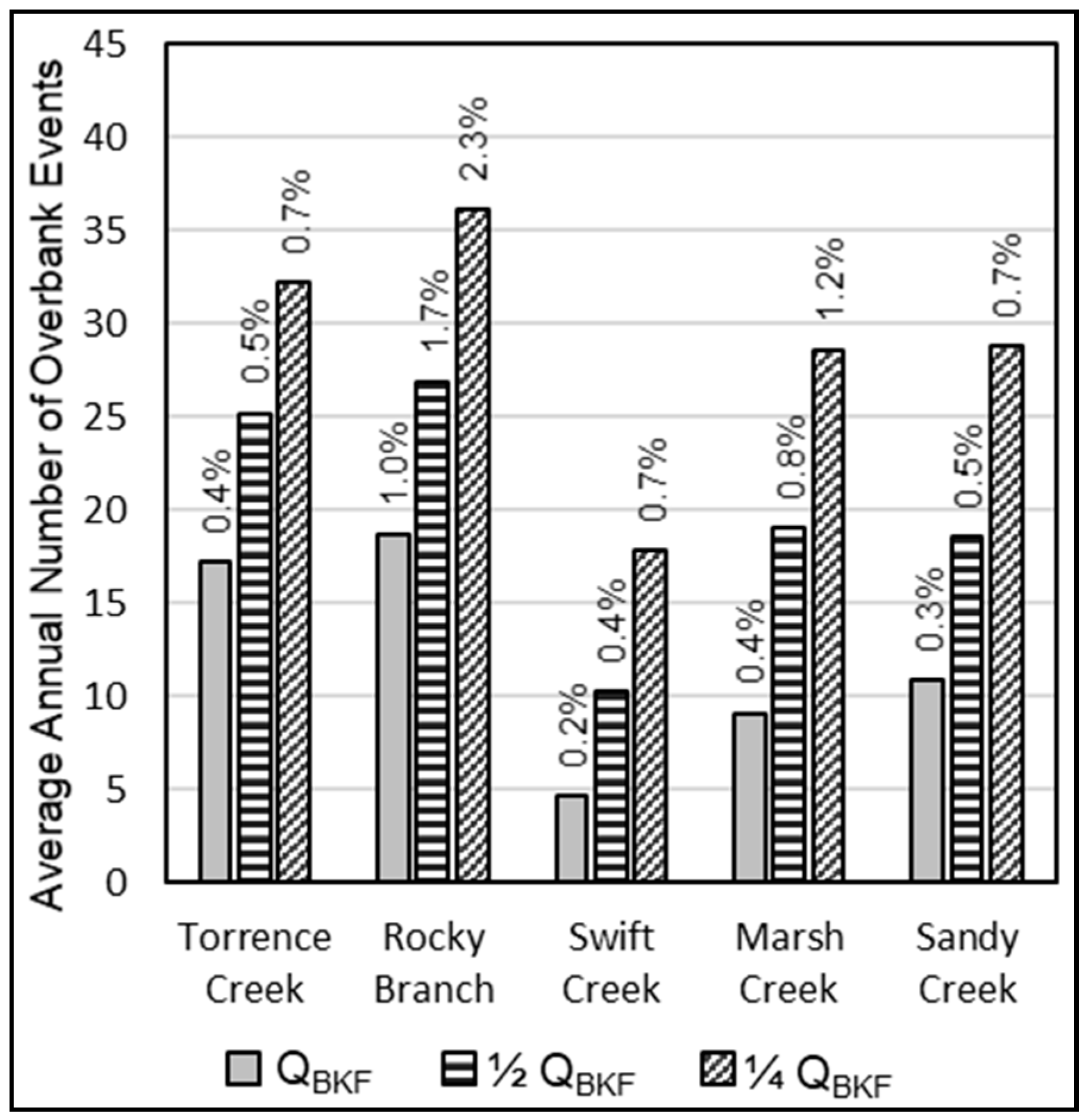
| Stream | Location | Watershed Area (km2) | Percent Impervious | Channel Width (m) * | Pre-Restoration BHR ** | USGS Station Number |
|---|---|---|---|---|---|---|
| Marsh Creek | Raleigh, NC, USA | 17.7 | 25% | 13.1 | 2.0 | 0208732885 |
| Rocky Branch | Raleigh, NC, USA | 2.5 | 40% | 7.1 | 3.0 | 0208735012 |
| Sandy Creek | Durham, NC, USA | 4.5 | 17% | 7.3 | 3.2 | 0209722970 |
| Swift Creek | Apex, NC, USA | 54.4 | 16% | 19.1 | 1.6 | 02087580 |
| Torrence Creek | Charlotte, NC, USA | 9.3 | 16% | 8.1 | 1.9 | 0214265808 |
| Stream | Watershed Area (km2) | Floodplain Area (km2) | Floodplain Area/Watershed Area | Available VTREAT (m3) |
|---|---|---|---|---|
| Marsh Creek | 17.7 | 0.07 | 0.4% | 20,969 |
| Rocky Branch | 2.5 | 0.03 | 1.3% | 10,361 |
| Sandy Creek | 4.5 | 0.03 | 0.7% | 9990 |
| Swift Creek | 54.4 | 0.17 | 0.3% | 50,942 |
| Torrence Creek | 9.3 | 0.02 | 0.2% | 6414 |
| Mean | 17.7 | 0.06 | 0.6% | 19,735 |
| Stream | QTOB 1 (cm) | Events > QTOB | QBKF 2 (cm) | Events > QBKF | % VFLOOD (%) | % VTREAT (%) | VTREAT/VFLOOD (%) |
|---|---|---|---|---|---|---|---|
| Marsh Creek | 65.1 | 0 | 8.5 | 9.1 | 11.9 | 2.0 | 22 |
| (5–15) | (3.1–25) | (1.2–3.0) | (7–38) | ||||
| Rocky Branch | 9.5 | 0 | 3.7 | 18.7 | 14.6 | 5.1 | 41 |
| (14–23) | (6.6–25) | (3.3–7.0) | (18–72) | ||||
| Sandy Creek | 32 | 0 | 4.2 | 10.9 | 10.1 | 1.5 | 27 |
| (6–16) | (1.1–21) | (0.7–2.2) | (9–69) | ||||
| Swift Creek | 42.5 | 2.3 | 18.7 | 4.6 | 9.0 | 1.0 | 13 |
| (2–8) | (4.4–14) | (0.6–1.4) | (4.3–23) | ||||
| Torrence Creek | 10.6 | 0 | 2.0 | 17.2 | 9.4 | 1.9 | 23 |
| (8–23) | (5.2–23) | (1.0–2.8) | (12–44) | ||||
| Mean | 31.9 | 0.5 | 7.4 | 12.1 | 11% | 2.3% | 25% |
| Stream | Mean TN (mg/L) | LTOTAL (kg/year) | LFLOOD (kg/year) | LTREAT (kg/year) | LRETAIN (kg/year) | % N Retained (%) |
|---|---|---|---|---|---|---|
| Marsh Creek | 0.78 | 6680 | 791 | 135 | 27 | 0.4 |
| (5132–8486) | (227–1602) | (87–231) | (17–46) | (0.2–0.6) | ||
| Rocky Branch | 1.83 | 3516 | 531 | 180 | 36 | 1.0 |
| (2820–4525) | (198–1121) | (100–232) | (20–46) | (0.7–1.4) | ||
| Sandy Creek | 0.84 | 4581 | 483 | 68 | 14 | 0.3 |
| (2691–7440) | (35–1039) | (23–114) | (5–23) | (0.1–0.4) | ||
| Swift Creek | 0.62 | 11,720 | 1102 | 118 | 24 | 0.2 |
| (6976–16,960) | (348–2123) | (61–214) | (12–43) | (0.1–0.3) | ||
| Torrence Creek | 0.56 | 2612 | 255 | 50 | 10 | 0.4 |
| (1892–3417) | (101–623) | (20–74) | (3.9–15) | (0.2–0.6) | ||
| Mean | 0.92 | 5822 | 632 | 110 | 22 | 0.5% |
© 2020 by the authors. Licensee MDPI, Basel, Switzerland. This article is an open access article distributed under the terms and conditions of the Creative Commons Attribution (CC BY) license (http://creativecommons.org/licenses/by/4.0/).
Share and Cite
Doll, B.A.; Kurki-Fox, J.J.; Page, J.L.; Nelson, N.G.; Johnson, J.P. Flood Flow Frequency Analysis to Estimate Potential Floodplain Nitrogen Treatment during Overbank Flow Events in Urban Stream Restoration Projects. Water 2020, 12, 1568. https://doi.org/10.3390/w12061568
Doll BA, Kurki-Fox JJ, Page JL, Nelson NG, Johnson JP. Flood Flow Frequency Analysis to Estimate Potential Floodplain Nitrogen Treatment during Overbank Flow Events in Urban Stream Restoration Projects. Water. 2020; 12(6):1568. https://doi.org/10.3390/w12061568
Chicago/Turabian StyleDoll, Barbara A., J. Jack Kurki-Fox, Jonathan L. Page, Natalie G. Nelson, and Jeffrey P. Johnson. 2020. "Flood Flow Frequency Analysis to Estimate Potential Floodplain Nitrogen Treatment during Overbank Flow Events in Urban Stream Restoration Projects" Water 12, no. 6: 1568. https://doi.org/10.3390/w12061568
APA StyleDoll, B. A., Kurki-Fox, J. J., Page, J. L., Nelson, N. G., & Johnson, J. P. (2020). Flood Flow Frequency Analysis to Estimate Potential Floodplain Nitrogen Treatment during Overbank Flow Events in Urban Stream Restoration Projects. Water, 12(6), 1568. https://doi.org/10.3390/w12061568





